Vagelis Hristidis
Progressive Query Expansion for Retrieval Over Cost-constrained Data Sources
Jun 11, 2024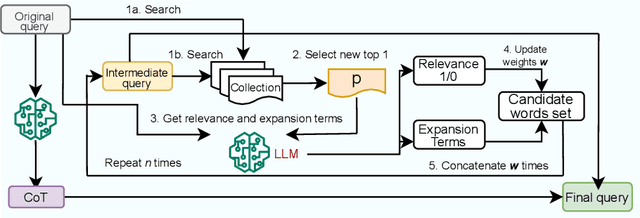
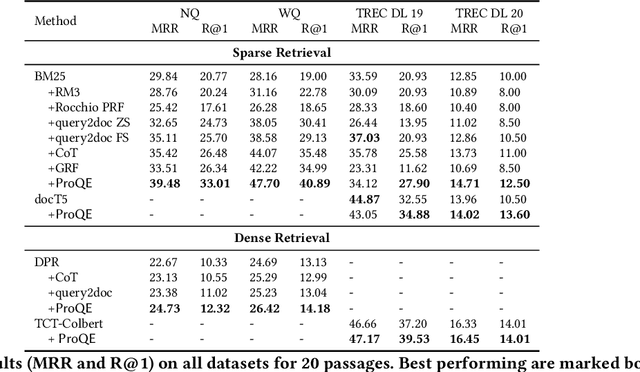
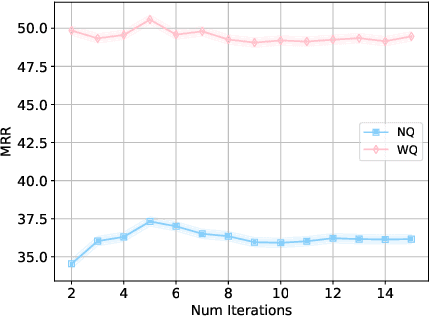
Abstract:Query expansion has been employed for a long time to improve the accuracy of query retrievers. Earlier works relied on pseudo-relevance feedback (PRF) techniques, which augment a query with terms extracted from documents retrieved in a first stage. However, the documents may be noisy hindering the effectiveness of the ranking. To avoid this, recent studies have instead used Large Language Models (LLMs) to generate additional content to expand a query. These techniques are prone to hallucination and also focus on the LLM usage cost. However, the cost may be dominated by the retrieval in several important practical scenarios, where the corpus is only available via APIs which charge a fee per retrieved document. We propose combining classic PRF techniques with LLMs and create a progressive query expansion algorithm ProQE that iteratively expands the query as it retrieves more documents. ProQE is compatible with both sparse and dense retrieval systems. Our experimental results on four retrieval datasets show that ProQE outperforms state-of-the-art baselines by 37% and is the most cost-effective.
PAT-Questions: A Self-Updating Benchmark for Present-Anchored Temporal Question-Answering
Feb 16, 2024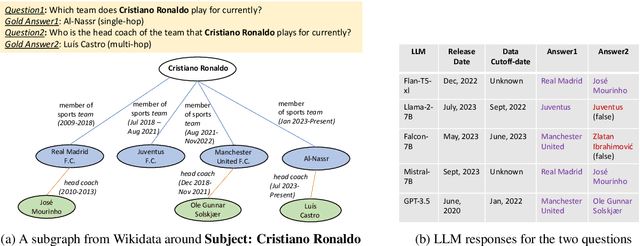
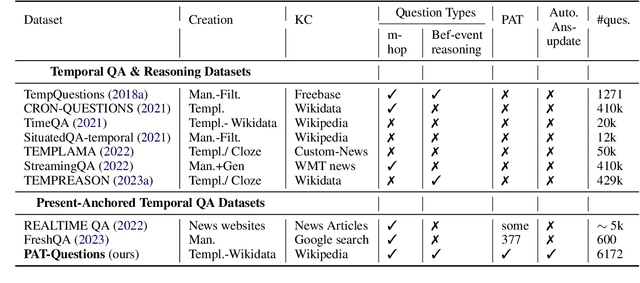


Abstract:Existing work on Temporal Question Answering (TQA) has predominantly focused on questions anchored to specific timestamps or events (e.g. "Who was the US president in 1970?"). Little work has studied questions whose temporal context is relative to the present time (e.g. "Who was the previous US president?"). We refer to this problem as Present-Anchored Temporal QA (PATQA). PATQA poses unique challenges: (1) large language models (LLMs) may have outdated knowledge, (2) complex temporal relationships (e.g. 'before', 'previous') are hard to reason, (3) multi-hop reasoning may be required, and (4) the gold answers of benchmarks must be continuously updated. To address these challenges, we introduce the PAT-Questions benchmark, which includes single and multi-hop temporal questions. The answers in PAT-Questions can be automatically refreshed by re-running SPARQL queries on a knowledge graph, if available. We evaluate several state-of-the-art LLMs and a SOTA temporal reasoning model (TEMPREASON-T5) on PAT-Questions through direct prompting and retrieval-augmented generation (RAG). The results highlight the limitations of existing solutions in PATQA and motivate the need for new methods to improve PATQA reasoning capabilities.
EcoRank: Budget-Constrained Text Re-ranking Using Large Language Models
Feb 16, 2024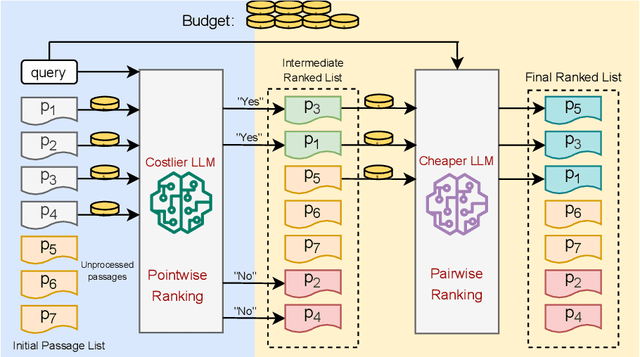

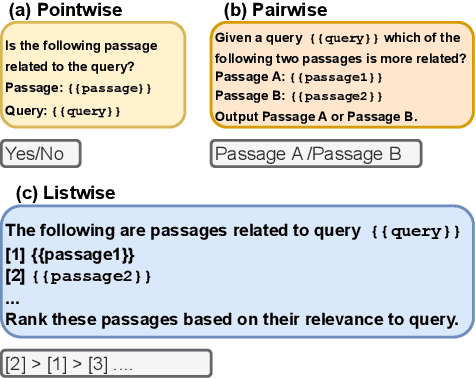
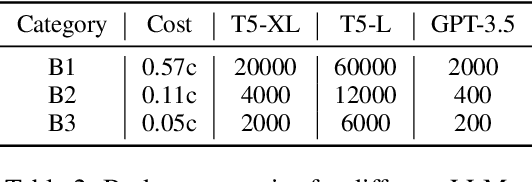
Abstract:Large Language Models (LLMs) have achieved state-of-the-art performance in text re-ranking. This process includes queries and candidate passages in the prompts, utilizing pointwise, listwise, and pairwise prompting strategies. A limitation of these ranking strategies with LLMs is their cost: the process can become expensive due to API charges, which are based on the number of input and output tokens. We study how to maximize the re-ranking performance given a budget, by navigating the vast search spaces of prompt choices, LLM APIs, and budget splits. We propose a suite of budget-constrained methods to perform text re-ranking using a set of LLM APIs. Our most efficient method, called EcoRank, is a two-layered pipeline that jointly optimizes decisions regarding budget allocation across prompt strategies and LLM APIs. Our experimental results on four popular QA and passage reranking datasets show that EcoRank outperforms other budget-aware supervised and unsupervised baselines.
NORMY: Non-Uniform History Modeling for Open Retrieval Conversational Question Answering
Feb 07, 2024Abstract:Open Retrieval Conversational Question Answering (OrConvQA) answers a question given a conversation as context and a document collection. A typical OrConvQA pipeline consists of three modules: a Retriever to retrieve relevant documents from the collection, a Reranker to rerank them given the question and the context, and a Reader to extract an answer span. The conversational turns can provide valuable context to answer the final query. State-of-the-art OrConvQA systems use the same history modeling for all three modules of the pipeline. We hypothesize this as suboptimal. Specifically, we argue that a broader context is needed in the first modules of the pipeline to not miss relevant documents, while a narrower context is needed in the last modules to identify the exact answer span. We propose NORMY, the first unsupervised non-uniform history modeling pipeline which generates the best conversational history for each module. We further propose a novel Retriever for NORMY, which employs keyphrase extraction on the conversation history, and leverages passages retrieved in previous turns as additional context. We also created a new dataset for OrConvQA, by expanding the doc2dial dataset. We implemented various state-of-the-art history modeling techniques and comprehensively evaluated them separately for each module of the pipeline on three datasets: OR-QUAC, our doc2dial extension, and ConvMix. Our extensive experiments show that NORMY outperforms the state-of-the-art in the individual modules and in the end-to-end system.
Generalized Zero-shot Intent Detection via Commonsense Knowledge
Feb 04, 2021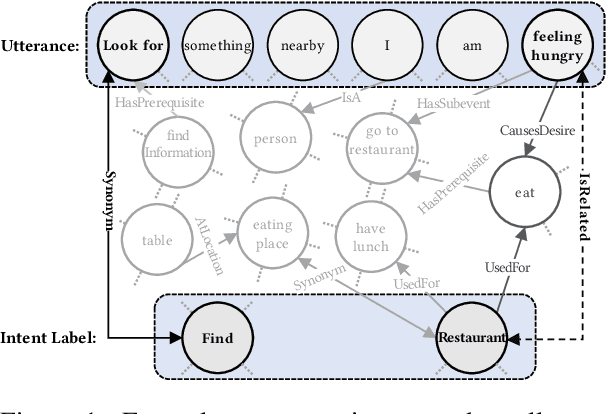



Abstract:Identifying user intents from natural language utterances is a crucial step in conversational systems that has been extensively studied as a supervised classification problem. However, in practice, new intents emerge after deploying an intent detection model. Thus, these models should seamlessly adapt and classify utterances with both seen and unseen intents -- unseen intents emerge after deployment and they do not have training data. The few existing models that target this setting rely heavily on the scarcely available training data and overfit to seen intents data, resulting in a bias to misclassify utterances with unseen intents into seen ones. We propose RIDE: an intent detection model that leverages commonsense knowledge in an unsupervised fashion to overcome the issue of training data scarcity. RIDE computes robust and generalizable relationship meta-features that capture deep semantic relationships between utterances and intent labels; these features are computed by considering how the concepts in an utterance are linked to those in an intent label via commonsense knowledge. Our extensive experimental analysis on three widely-used intent detection benchmarks shows that relationship meta-features significantly increase the accuracy of detecting both seen and unseen intents and that RIDE outperforms the state-of-the-art model for unseen intents.
Linguistically-Enriched and Context-Aware Zero-shot Slot Filling
Jan 16, 2021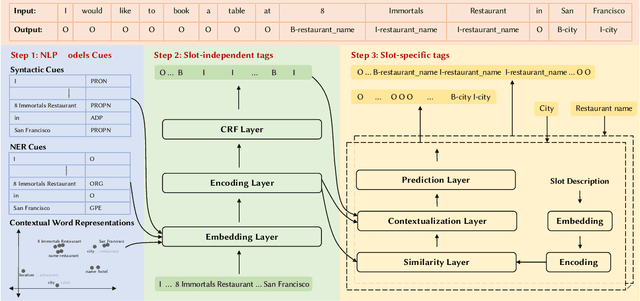
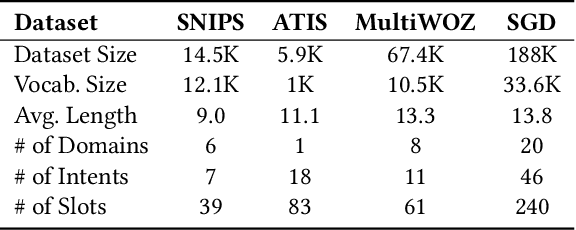
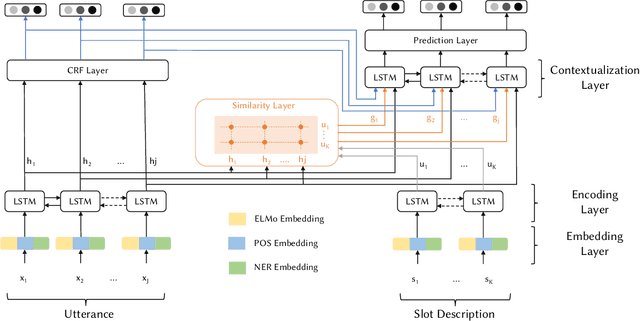

Abstract:Slot filling is identifying contiguous spans of words in an utterance that correspond to certain parameters (i.e., slots) of a user request/query. Slot filling is one of the most important challenges in modern task-oriented dialog systems. Supervised learning approaches have proven effective at tackling this challenge, but they need a significant amount of labeled training data in a given domain. However, new domains (i.e., unseen in training) may emerge after deployment. Thus, it is imperative that these models seamlessly adapt and fill slots from both seen and unseen domains -- unseen domains contain unseen slot types with no training data, and even seen slots in unseen domains are typically presented in different contexts. This setting is commonly referred to as zero-shot slot filling. Little work has focused on this setting, with limited experimental evaluation. Existing models that mainly rely on context-independent embedding-based similarity measures fail to detect slot values in unseen domains or do so only partially. We propose a new zero-shot slot filling neural model, LEONA, which works in three steps. Step one acquires domain-oblivious, context-aware representations of the utterance word by exploiting (a) linguistic features; (b) named entity recognition cues; (c) contextual embeddings from pre-trained language models. Step two fine-tunes these rich representations and produces slot-independent tags for each word. Step three exploits generalizable context-aware utterance-slot similarity features at the word level, uses slot-independent tags, and contextualizes them to produce slot-specific predictions for each word. Our thorough evaluation on four diverse public datasets demonstrates that our approach consistently outperforms the SOTA models by 17.52%, 22.15%, 17.42%, and 17.95% on average for unseen domains on SNIPS, ATIS, MultiWOZ, and SGD datasets, respectively.
AARSynth: App-Aware Response Synthesis for User Reviews
Aug 28, 2020Abstract:Responding to user reviews promptly and satisfactorily improves application ratings, which is key to application popularity and success. The proliferation of such reviews makes it virtually impossible for developers to keep up with responding manually. To address this challenge, recent work has shown the possibility of automatic response generation. However, because the training review-response pairs are aggregated from many different apps, it remains challenging for such models to generate app-specific responses, which, on the other hand, are often desirable as apps have different features and concerns. Solving the challenge by simply building a model per app (i.e., training with review-response pairs of a single app) may be insufficient because individual apps have limited review-response pairs, and such pairs typically lack the relevant information needed to respond to a new review. To enable app-specific response generation, this work proposes AARSynth: an app-aware response synthesis system. The key idea behind AARSynth is to augment the seq2seq model with information specific to a given app. Given a new user review, it first retrieves the top-K most relevant app reviews and the most relevant snippet from the app description. The retrieved information and the new user review are then fed into a fused machine learning model that integrates the seq2seq model with a machine reading comprehension model. The latter helps digest the retrieved reviews and app description. Finally, the fused model generates a response that is customized to the given app. We evaluated AARSynth using a large corpus of reviews and responses from Google Play. The results show that AARSynth outperforms the state-of-the-art system by 22.2% on BLEU-4 score. Furthermore, our human study shows that AARSynth produces a statistically significant improvement in response quality compared to the state-of-the-art system.
Unsupervised Paraphrasing via Deep Reinforcement Learning
Jul 05, 2020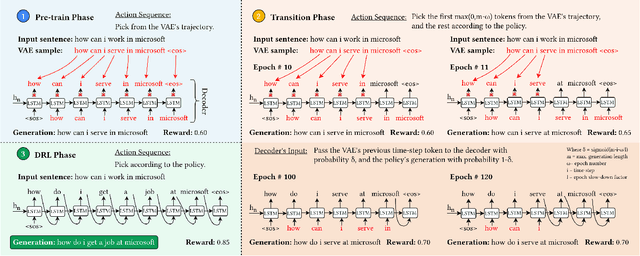
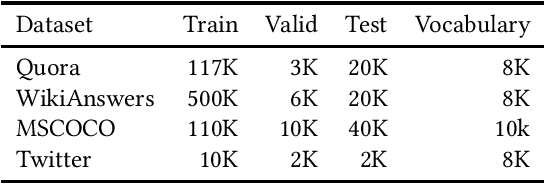
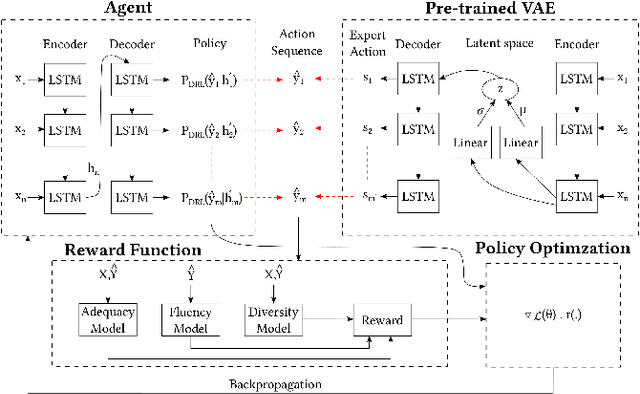
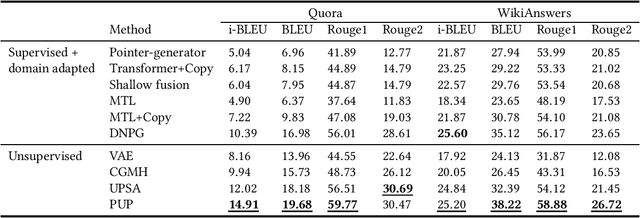
Abstract:Paraphrasing is expressing the meaning of an input sentence in different wording while maintaining fluency (i.e., grammatical and syntactical correctness). Most existing work on paraphrasing use supervised models that are limited to specific domains (e.g., image captions). Such models can neither be straightforwardly transferred to other domains nor generalize well, and creating labeled training data for new domains is expensive and laborious. The need for paraphrasing across different domains and the scarcity of labeled training data in many such domains call for exploring unsupervised paraphrase generation methods. We propose Progressive Unsupervised Paraphrasing (PUP): a novel unsupervised paraphrase generation method based on deep reinforcement learning (DRL). PUP uses a variational autoencoder (trained using a non-parallel corpus) to generate a seed paraphrase that warm-starts the DRL model. Then, PUP progressively tunes the seed paraphrase guided by our novel reward function which combines semantic adequacy, language fluency, and expression diversity measures to quantify the quality of the generated paraphrases in each iteration without needing parallel sentences. Our extensive experimental evaluation shows that PUP outperforms unsupervised state-of-the-art paraphrasing techniques in terms of both automatic metrics and user studies on four real datasets. We also show that PUP outperforms domain-adapted supervised algorithms on several datasets. Our evaluation also shows that PUP achieves a great trade-off between semantic similarity and diversity of expression.
 Add to Chrome
Add to Chrome Add to Firefox
Add to Firefox Add to Edge
Add to Edge